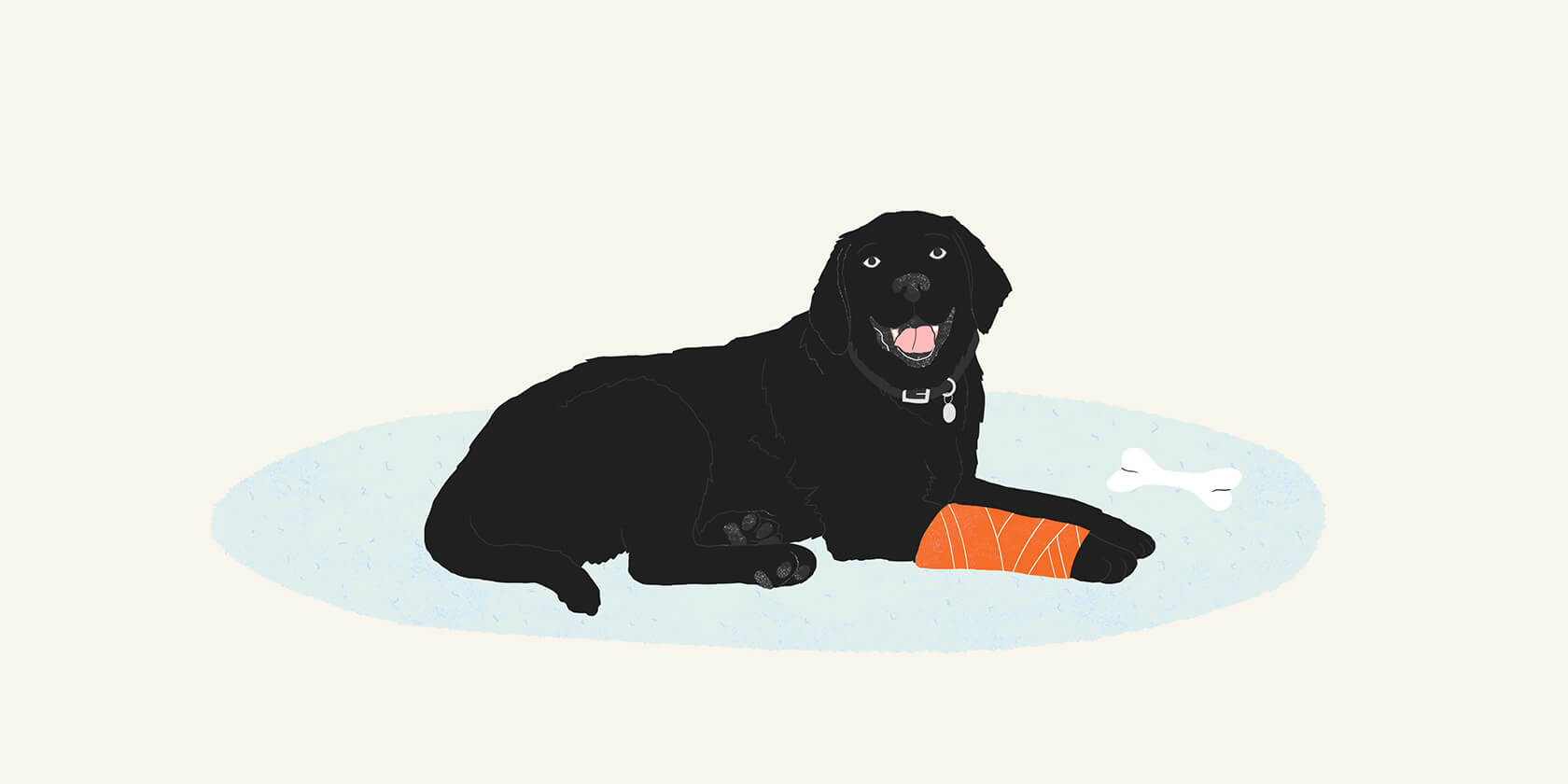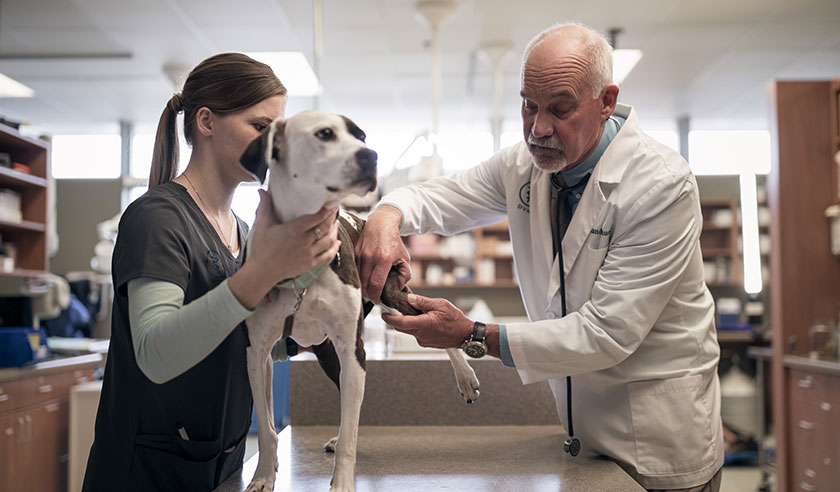While people and dogs have obvious differences, we share one really big thing — bones! And you guessed it — they can suffer from broken bones just like can. But do they feel the same sensations? Are a dog’s broken bones treated the way human breaks are treated? Do they heal more quickly? What can you expect if your dog breaks a bone?
A Broken Bone from Your Dog’s Point of View
Any bone in the body, from the toes to the jaw and down the back to the tail, can be fractured. Dogs most often have breaks in the bones of the front and back legs or the pelvis.
If your dog has a mild break, they may experience mild to moderate swelling, discomfort, and pain.
Severe breaks can cause more trauma to the surrounding tissue, so there is often significant pain and swelling. Often, severe breaks are due to a very traumatic event which can result in other internal and external injuries and the dog going into shock.
Signs of Broken Bones in Dogs
There are times when broken bones will be obvious and other times when they’re harder to recognize.
Open fractures, for example, mean the bone is protruding through the skin, so they’re easy to see. On the other hand, a closed fracture occurring under the skin and other soft tissues may not be visible to you.
In most cases, your dog will exhibit severe lameness in the affected limb, holding it up and being unable to bear weight on it. Sometimes, though, depending on the location and the type of break, they can still stand and hold some of their weight on the injured leg. You may notice other signs though, like swelling, pain, reluctance to be touched, or abnormal movements. They may also vocalize at the time the break occurs or whimper afterward.
In cases of fractures to the pelvis, the most notable sign is sudden, mild to severe lameness of the hind legs.
What to Do If You Think Your Dog May Have A Broken Bone
If you suspect your dog may have a broken bone or they’ve been involved in an accident, it’s vital to speak with a veterinary professional right away to have them assessed and avoid complications.
Getting your dog to the veterinary hospital should be done carefully to avoid worsening the injury or causing your pet more pain. If they’re small enough to be carried, lift them at their shoulder and hips, supporting their head and spine, and carefully place them in the car on their non-injured side. Do your best to keep the broken limb as stable as possible but do not attempt to “set” it. Support it by cradling it with pillows or bulky blankets. For larger dogs who can walk on three legs, help them balance and get into the vehicle with a sling. You can use a towel or blanket. Run it under your dog’s body and hold the two ends tightly above their body to carry some of their weight for them. For those unable to walk, place them on a heavy blanket and, with a helper, carry them like they’re on a gurney. Upon arrival at the veterinary clinic, advise them of the situation and let them remove your dog from the vehicle.
It’s very important to remember that your dog is scared and in pain. They may react with growling, snapping, or yelping when you go near the injured area or move them. If they’re aggressive, consider a muzzle temporarily so you can transport them safely. Always remain calm and speak softly.
You may find yourself in a situation where you can’t make it to a veterinary hospital immediately. If you have a long drive or there’s a long wait at the hospital, for example, do your best to confine your dog to a small room or crate that’s well padded. An ice pack (covered with a cloth) can be applied for 10 to 15 minutes to help control swelling. Only attempt this if your dog is willing to tolerate it. Even if you can’t get to the hospital quickly, it’s important to speak to a qualified veterinary professional, so they can advise you on care until your dog can be seen.
Types of Bone Fractures in Dogs
The medical term used to describe a broken bone is “fracture.” Trauma is the most common cause, including being hit by a car, falling from a height, fighting, being stepped on, etc. Dogs also suffer fractures from athletic activities or an abnormal jump off furniture. Fractures may also occur due to another disease process weakening the bone, such as bone cancer or certain hormonal conditions.
A fracture can be incomplete, meaning the bone is only broken part of the way around its circumference, or complete, when the bone is broken completely through its circumference, and two or more fragments of bone are created.
Complete fractures are described in more detail based on the shape of the break.
Transverse Fracture
The break is straight across the bone.
Oblique Fracture
The break is diagonal across the bone. A sharp point is created on both bone fragments.
Comminuted Fracture
The break causes the bone to be in three or more pieces, and the shapes vary.
Open fractures, where the break creates an opening in the skin, are very dangerous since bacteria can enter the site and cause an infection.

Diagnosis and Treatment for Broken Bones in Dogs
In addition to a physical examination, radiographs will be taken from various angles to understand the full extent of the break.
Promoting rapid healing is the main objective. Depending on location and severity, some can heal well with conservative treatment such as splints or casts, much like you see when a human breaks an arm or leg.
In many cases, however, surgical stabilization is recommended, restoring the bone to its original anatomic location and locking it into position with metal surgical implants such as wires, pins, plates, or screws.
This procedure is recommended more for dogs than humans. Why? Dogs more commonly fracture the major long bones close to the body. These bones are hard to stabilize properly with cast or splints since the joint above and below the fracture site must remain immobile for healing. It can also be challenging to maintain a cast or splint on a dog, keep it clean, dry, and in the right place. Pressure sores under the bandage are common. And the weight of the cast or splint can make movement problematic, especially for small breeds.
It can take 2 to 3 months for the entire healing process. If proper restrictions are not put in place for activity, it will likely take longer. For young puppies, fractures need a minimum of 4 weeks to heal. Older dogs, however, require about 8 to 12 weeks for healing.
Depending on the severity and the length of the healing period, physical therapy may help your dog regain full function. For best results, it is important to follow your veterinary team’s recommendations regarding cast, splint, and/or surgical site care, pain management, activity restriction, and medical progress recheck appointments.
ZPC-01752R1





